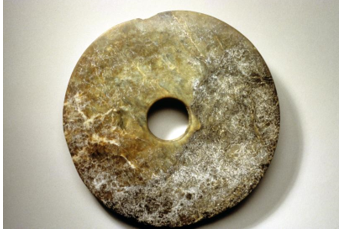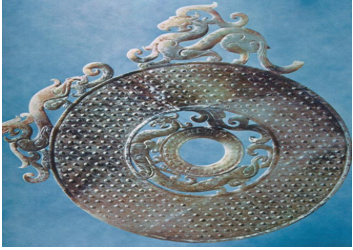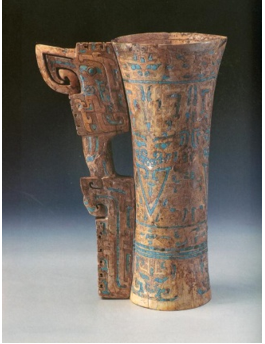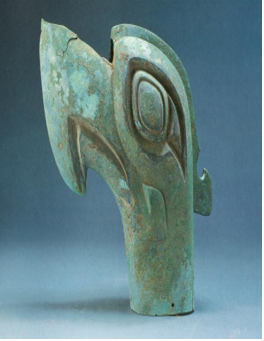Section 1
Figure1: Bi ritual Jade and Jade Bi.
On the right is Bi, Ritual jade disk, an artistic object that belongs to the Liangzhu culture. The Liangzhu culture, which existed between 3400-2500 BC, is considered the last culture under the Neolithic Jade age in China. The recognition of this culture is relatively recent because the excavation of Liangzhu city was completed in 2006. Liangzhu was a large walled Chinese settlement located in Hangzhou to the south of River Yangzi in Zhejiang Province. In this site, studies have revealed a large number of remarkable items associated with the Liangzhu culture. Based on studies in these items, it is possible to determine the nature of this culture.
The artistic object on the right is Jade bi with two dragons on the exterior trim, which belongs to the Eastern Zhou Dynasty known as the Warring State period. During this period, there was an intensive political turmoil, yet the artistic and cultural development was rapid. Bronze and jade were the most important materials for arts, which were used for religious ritual and state purposes. Most of the objects were commissioned by rulers to represent their status and wealth, which led to the rapid development of art culture. Decorative techniques were applied to increase the aesthetic value of the objects, especially those developed for the rulers.
The Bi, Ritual jade disk on the left is made of nephrite, a calcium-magnesium-based rock that was common in Zhejiang Province, especially along the Yangzi River. During the Liangzhu era, nephrite was an important source of material for artistic objects, especially those meant for ritual purposes. The Bi Jade on the left is an important example of art objects that were made for ritual purposes, which compares with the Bi jade with two dragons on the right, which was made for decorative purposes.
On the other hand, the Jade bi with two dragons on the rim, which is on the right in the table above, is made of jade rather than nephrite. Like nephrite, jade was a significant material for artistic objects for ritual and other non-religious purposes. Unlike nephrite, jade allowed the artists to paint the objects easily, which explains why the bi on the right is decorated.
The artistic formats used in developing the two objects are relatively different from each other. For instance, the ritual jade bi on the left is circular with a hole in the middle. Its outer rim has an irregular margin, which suggests that the technique used was relatively crude when compared with the non-ritual jade in the right.
The techniques used in the two cultures represented by the two objects, in this case, are also different. The ritual jade seems to emphasize more the religious significance of the object than aesthetic value. The object is heavy and assumes a single color, with little evidence of decorative techniques applied on its surface. On the other hand, the non-ritual jade on the right seems to be a product of an organized work as indicated by the presence of carvings and decorative patterns on its two rims.
Section 2
Figure 2: Bei Cup and Bird’s Head.
Both Objects belong to the Shang dynasty that lasted between 1766 BC and 1040 BC. The Bei (cup) on the left belongs to the Fu Hao Culture, which existed during the Shang Dynasty. It is one of a large number of artistic objects excavated from the tomb of Fu Hao at Yinxu in the modern-day Anyang city of Henan Province in China. The culture is named after Queen Fu Hao, the most powerful wife of King Wu Ding. She was also a military general before she died in 1200 BCE.
From the excavations, the Fu Hao culture provides evidence of religious rituals in the burial sites for prominent people in the society. It is worth noting that the Shang Dynasty ha a culture of writing in addition to artwork, which increases the quality of the available information about the culture. The culture emphasized life after death as well as the connection between the living and gods.
The artistic objects from the Fu Hao tomb reveal that the society recognized various divinities, including the high god Di and other nature gods. The queen consulted her ancestors to communicate with the gods, as indicated by the writings as well as the presence of various art objects representing these gods. Also, oracle bones found on the site represent the questions that the queen was supposed to pose to her ancestors once she reaches the world of spirits.
Although the two objects belong to the same culture and dynasty, they differ in several artistic aspects. For instance, the Bei Cup is a mug that was placed inside the tomb of the Queen. It is an indication that the departing spirit would need some kitchen items in her life after death. The mug is one of the royal objects placed beside the queen’s body, which she needed in her journey. The mug is also one of the expensive objects in the tomb, which provides information on the nature of the Fu Hao culture.
The two objects are also made from different materials. The medium used to develop the Fu Hao’s Bei is Ivory, which suggests the status of the queen. Ivory was an important medium of trade and measure of wealth. The cup is made of pure ivory, despite its large size. This is an indication that Fu Hao was a wealthy and noble individual in society. A large amount of ivory used to develop the cup is an indication of the quality of life that the queen had lived and expected to lead after death. Ivory work was a common artistic style during the Shang dynasty, as indicated by the complex architecture of the cup. It indicates that ivory work had evolved during the Shang Dynasty, which included the ability to shape ivory into complicated shapes as well as inscribing on the material.
On the other hand, Bird’s Head on the right is made of bronze, one of the most common materials that were used for art during the Shang Dynasty. It is an indication of the value that people attributed to their gods. For instance, bronze was relatively expensive, although it was cheaper and more available than ivory. Bronze work allowed artists to curve complicated shapes and figures. Also, it allowed the artists to develop large and small figures, including although the two objects belong to the same culture and era, they differ in the techniques used to make them because the materials are different.
Ivory carving was used to make Fu Hao’s cup while bronze casting was used to develop the bird’s head on the right. Working with ivory was cheaper and simpler than bronze work. Ivory work required carving skills using simple tools that only needed to be sharp. On the other hand, bronze casting is a long and laborious process that started with bronze melting and making stone or wax models on which the molten bronze was cast.
As indicated above, the subject matters of the two objects are relatively different, even though both are religious symbols. Fu Hao’s ivory cup was made for kitchen use when the person was still alive. It is one of the various utensils in the queen’s kitchen. This means that the decorations on the object were made for aesthetic rather than religious value. The cup served the purpose of holding drinks such as tea, which was a common beverage in the ancient Chinese kingdoms.
Arts of China
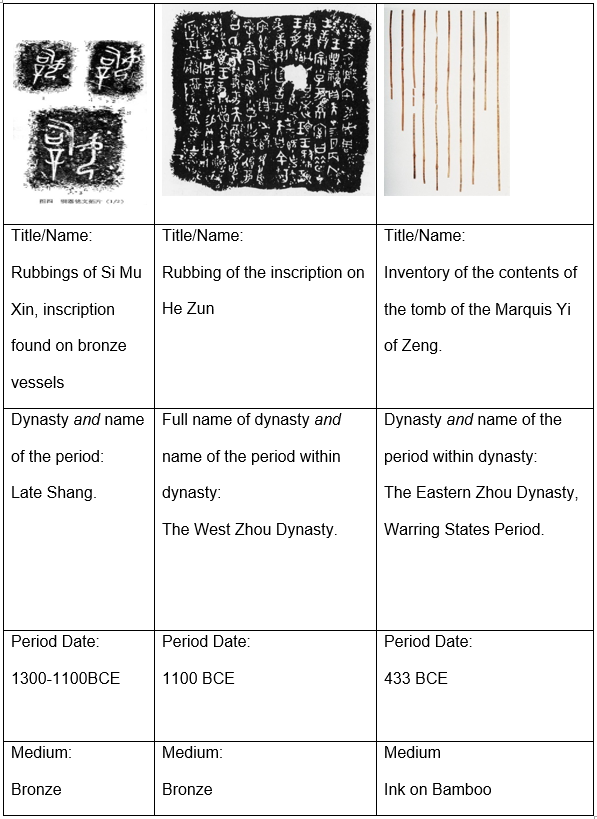
The Rubbings of Si Mu Xin, inscription found on bronze vessels belong to the Shang Dynasty that lasted 1300 to 1100 BCE. They were meant to signify Queen Fu Hao’s title after death. On the other hand, the Rubbing of the inscription on He Zun belongs to the West Zhou culture and was developed sometime sin 11000 BCE.
Therefore, the three objects represent three different Chinese cultures worth analysis. First, the writings “Si Mu Xin” are found on various vessels discovered in the tomb of Queen Fu Hao. They provide the queen’s title after death, which indicates that the culture recognized a dead person with a different name. It implies that the queen was to assume a new title in her life after death. The culture indicated that there was a strong belief in life after death. Also, it indicates that the people held their ancestors with respect and believed in life after death.
The ‘Rubbing of the inscription on He Zun’ belongs to the West Zhou culture. As indicated above, the West Zhou culture lasted between the 11th century BC and 771 BC. The political leaders paid much attention to arts, especially etiquette. Almost all events were signified by artistic symbols. For instance, weddings, sacrificial rituals, funerals, and other events had distinct symbols. Bronze, bones, ivory, and stone were used in developing artistic symbols. Also, religious and spiritual aspects were symbolized with art objects. Moreover, domestic objects such as kitchenware and other items were developed from these materials, with an emphasis on decorations. It is also worth noting that reading and writing was an important method of communication as well as the preservation of history.
The ‘Inventory of the contents of the tomb of the Marquis Yi of Zeng’ is artistic symbols discovered in an excavation site in Suizhou, Hubei in China. The tomb of Marquis Zeng is dated 433 BC and is one of the few tombs that remained intact over the centuries. The tomb belongs to the Warring States period of the Eastern Zhou Dynasty. As indicated above, the period was an era of intensive political turmoil, but the artistic and cultural development was rapidly developing. There was a major shift from the artwork of religious aspects to the aesthetic and decorative style of art. Due to a booming economy, wealthy people and nobles commissioned various art projects to signify their social status or wealth. Also, expensive ornaments and houseware were part of the rich people’s life.
The inscriptions on the vessels found at Queen Fu Hao’s vessels were made on clay and bronze objects. The writings provide the queen with a new title “Si Mu Xin” rubbed from the “ding”. The writings are made in Chinese letters, indicating the importance of writing in the culture.
The purpose of writing on the tombs as well as the objects placed beside the dead person was to communicate with the ancestors. The queen’s new name was communicated to the ancestors through writing. The people believed that ancestors were able to read and understand the will of the dead person. Thus, these writings provide evidence of a strong relationship between living people and their ancestors.
On the contrary, the inscriptions of He Zun’s vessel were made through rubbing. It is a piece of the works of Li, a scribe in the palace of King He Zun. Unlike the writings on Fu Hao’s tomb, these inscriptions had the purpose of commemorating the precious metals, especially gold and bronze ores, that were given to Li by the king one week after the kingdom conquered the Shang Kingdom. The writings claim that the battle of Muye took place after the king realized that the planet Jupiter was standing in a new position. Also, the writings indicate that the battle was short but involving. Nevertheless, some parts of the writings do not make any meaning. For instance, the third sentence does not make any meaning, although historians believe it was meant to specify some sacrificial preparations before the battle.
Like Hu Fao’s objects, He Zun’s inscriptions are made on bronze vessels, most of which were used for holding beverages. The texts are made on the sides of the vessels, which are cylindrical but with a large base. Also, the writings protrude above the surface of the vessel, which indicates that molding was used as a writing technique rather than the incision.
On the other hand, the inventory of the contents found at the tomb of Marquis Yi of Zeng is located at Wuhan, the capital of Hubei Province of China, where the ancient city of Zeng was located. The objects are among other artistic items found on the tomb of Yi, which was made for religious purposes. The picture on the right side of figure 3 above represents some musical treasures found on the tomb. The presence of musical instruments in the bronze tomb suggests that the king was fond of music. For instance, there were 65 Bian Zhong bells in the tomb. They were stuck with mallets made of wood, which allowed the bells to produce musical sounds. The inscriptions on the bells indicate that the tomb was made sometimes in 433BC.
Like the writings of Fu Hao, the inventories in the tomb of Marquis provide evidence of belief in life after death. They were made to produce music and comfort to the king in his life after death. Unlike the other two writings, the inventions are made of wood rather than bronze. The carving technique was made on the hardwood. Also, decorations were not made on the instruments, unlike other objects found in the tombs such as the vessels in Hu Fao’s tomb.
It is also worth noting that unlike using bronze, the inventions on Marquis Yi’s tombs were made on ink and bamboo. They provide some evidence that the art of making writing pens from bamboo was thriving during the era. In particular, bamboo pens and ink were available in the market and were used in Chinese schools, business sectors, and palaces, where scribes were an important individual in the kingdom.
Chinese arts 4
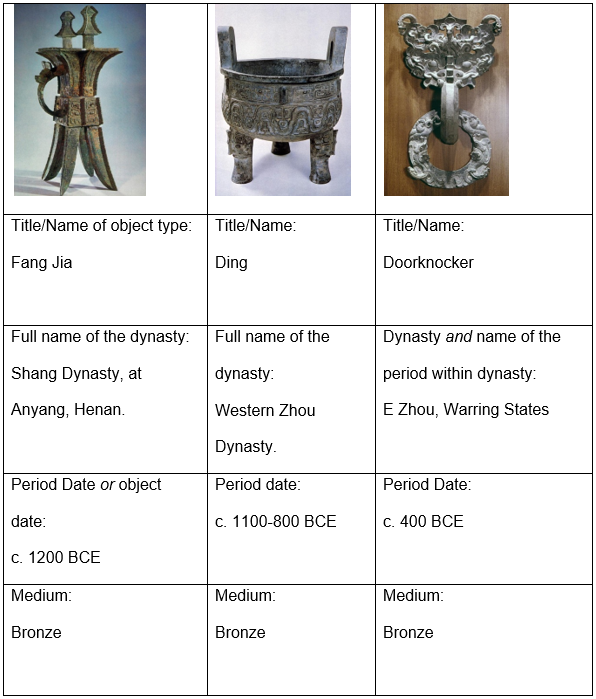
In figure 4 above, Fang Jia, Ding, and the Doorknocker are Chinese artistic objects from Shang, Western Zhou, and Warring State Dynasties respectively. As indicated in sections 1, 2, and 3 above, each of the three dynasties had a unique artistic culture that signifies various aspects of life at the time. For instance, the Shang Dynasty, to which the Fang Jia belongs, was established in the Yellow River Valley and existed between 1766 and 1122 BC. Shang Dynasty is an important era in Chinese history of arts because major improvements were made during this period. For instance, bronze casting techniques improved significantly, which made it possible to produce delicate musical instruments, sculptures, and other objects. Animal bones and teeth, bronze, clay, and jade were important materials for artwork.
On the other hand, the Western Zhou dynasty, from which the Ding belongs, lasted between 1050 and 771BC. During this era, the political leaders paid much attention to the arts, especially etiquette. Almost all events were signified by artistic symbols. For instance, weddings, sacrificial rituals, funerals, and other events had distinct symbols. Bronze, bones, ivory, and stone were used in developing artistic symbols.
Also, religious and spiritual aspects were symbolized with art objects. Moreover, domestic objects such as kitchenware and other items were developed from these materials, with an emphasis on decorations. It is also worth noting that reading and writing was an important method of communication as well as the preservation of history.
The Doorknocker belongs to the Warring States dynasty. As indicated in sections 1 and 3, this dynasty had a unique culture in which people deviated from putting much emphasis on rituals and started focusing on personal status, wealth, and decorations for aesthetic value. Bronze and jade were the most important materials for arts, which were used for religious ritual and state purposes. Most of the objects were commissioned by rulers to represent their status and wealth, which led to the rapid development of art culture.
Decorative techniques were applied to increase the aesthetic value of the objects, especially those developed for the rulers. Also, the culture was signified by long inscriptions on bronze and jade to reflect the desire of the elites to show off their wealth and status in the society.
The three objects are made from bronze, an important aspect of ancient Chinese cultures. The Fang Jia is a Chinese vessel used to hold wine for rituals, especially as veneration for ancestors. It has four legs, although some forms of Jia had three legs. The purpose of the Jia is to perform various ceremonies, where ancestors were considered as an important aspect of human life. The object has various decorations, especially in geometrical forms as well as motifs that symbolize religious beliefs between the Chinese. The Fang Jia is decorated using incision skills, which were made before the cooling of the bronze material. This is also similar to the Ding and the Doorknockers.
The objects were made of molten Bronze, a process that is relatively laborious and difficult. The Ding, like the Jia, has various decorations on the outer part. It is a type of a vase used to hold liquids as well as foods during rituals, especially those dedicated to the ancestors. On the other hand, the doorknocker was used to decorate purposes, especially on the doors of prominent people such as the nobles and the wealthy individuals.
Bibliography
Allan, Sarah. The Formation of Chinese Civilization: An Archaeological Perspective. London, UK: Yale University Press, 2009.
Brigstocke, Hugh. The Oxford Companion to Western Art. London, UK: Oxford university press, 2001.
Cook, Constance, and John Major. Defining Chu: Image and Reality in Ancient China. Hawaii: University of Hawaii Press, 2011.
DeWoskin, Kenneth J. “Marquis of Zeng: Babylonian biophysics in ancient China”. Journal of social biology structure 10, no. 2 (1987): 329-341.
Keightley, David. “Art, Ancestors, and the Origins of Writing in China.” Representations 56, no. 3 (2006): 68–95.
Osborne, Harold, and Antonia Boström. Ivories. London, UK: Oxford University Press, 2006.
Osborne, Harold. The Oxford Companion to the Decorative Arts. London, UK: OUP, 2007.
Rawson, Jessica. The British Museum Book of Chinese Art. London: British Museum Press, 2007.
Williamson, Paul. An Introduction to Medieval Ivory Carvings. New York, NY: HMSO for V&A Museum, 2004.
Suzie, Lui. Chinese Architecture: The Origins of Chinese Architecture. London, UK: Yale University Press, 2010.
Ying, Zhou. The Dawn of the Oriental Civilization: Liangzhu site and Liangzhu culture. Beijing: China Intercontinental Press, 2007.
